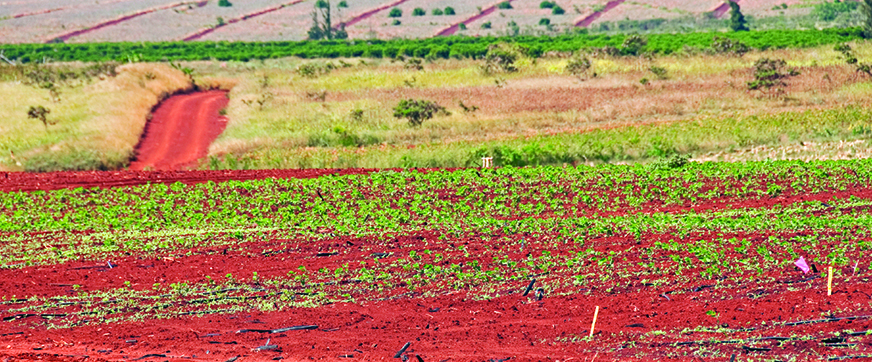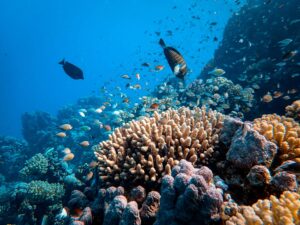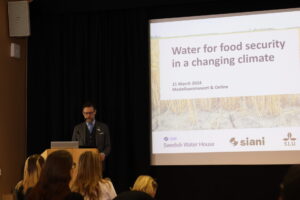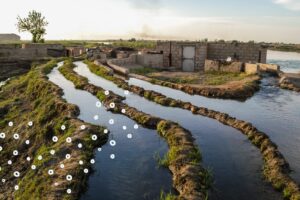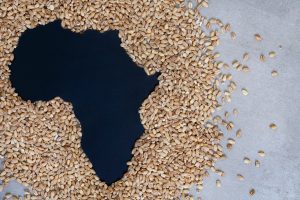Fewer, tastier tomatoes: Expanding the use of saltwater in agriculture
As the world experiences increasing freshwater crises, researchers turn to saline waters. Can the use of saltwater be expanded? Absolutely, write Kenneth M. Persson and Linus Zhang. From the March 2016 issue of Stockholm WaterFront Magazine.
The development of appropriate practices for the use of saline waters for irrigation requires an adequate understanding of how salts affect waters, soils and plants, as FAO states in their book The use of saline waters for crop production, 1992. Plants can grow in saline waters, if the salinity of the soil is controlled and monitored, and the soil salt content is not allowed to increase past a level that damages the plants. Irrigation of salt tolerant plants with slightly saline waters offers a substantial opportunity to increase the yearly crop production of the world.
All natural waters contain more or less salts, i.e. minerals. A common classification of water salinity is that if the electrical conductivity is below 0.7 dS/m (deciSiemens per metre), corresponding to a salt content of less than 500 mg/l, the water is fresh and can be used with little problems for irrigation and other water supply purposes. Slightly saline waters, sometimes useful for irrigation, have a conductivity from 0.7 up to 2 dS/m (500-1500 mg/l) while another group is the highly saline waters which have a conductivity of 10-25 dS/m (7000 – 15 000 mg/l). Sea waters can have up to 45 dS/m (>40 000 mg/l).
Saline waters can be used for crop irrigation and moreover have been used for millennia. In a recent paper in PLOS One by Zhai, Yang and Hou on the effects of saline water drip irrigation on tomato yield and quality, a three-year study on the effects of saline water irrigation was presented for different soil salt contents. Saline water differing in electrical conductivity (from 3 dS/m to 5.5 dS/m) was supplied to the plant after the seedling establishment. Irrigation water with 5.5 dS/m salinity reduced the maximum leaf area index and chlorophyll content most significantly when compared with other salinity treatments. However, compared with the freshwater control treatment, a slight increase in leaf area index and chlorophyll content was observed with 3~4 dS/m salinity. Saline water decreased the yield with around 20 per cent compared with the control, but improved tomato quality, including fruit density, soluble solid, total acid, vitamin C and the sugar-acid ratio.
Actually, a number of plant species can grow also in moderately saline soils and water. Many scientific studies have been performed proving the potential use of moderately saline water for irrigation. The use of saline drainage water in Egypt is well known and has been applied for millennia. In California, USA, moderately saline drainage water is commonly used for crop production. One example can be found in the Broadview Water District of California, where saline sub-surface drainage water since 1956 has been blended with Delta-Mendota Canal water to form irrigation water of a salinity equivalent to 3.2 dS/m. It has since been used to irrigate a variety of crops, changing with the salt content of the irrigation water. Cotton, barley and alfalfa are the most common crops grown at present. In other countries, like China, Tunisia, India and Israel, the use of brackish groundwater for irrigation is known, to grow sugar beet, citrus or maize, for instance. The importance of brackish water irrigation has increased with the development of deep wells. After irrigation, the salinity of the drainage water increases and this can be used to keep a careful balance of the supply of salt to the soil and removal of salt from the soil with the use of excess drainage water. Depending on water quality, overall salinity but also the composition of minerals in the water, accumulation of soil salinity can be avoided and minerals prone for precipitation, such as gypsum, calcium sulphate, must be kept dissolved in the water.
Among agricultural scientists, great efforts have been made to develop crops that can withstand higher salinities in soil and water. When the plant is tolerant of saline conditions, it must apply methods of balancing the toxic and osmotic effects of the increased salt concentrations, which can be reached through the use of stress proteins and compatible cytoplasm osmotic solutes, such as sequestration of salt and storage of it within the vacuole to protect more vulnerable areas of the cell. Salt tolerant plants can build up higher concentrations of sugars, amino acids and quaternary ammonium bases to balance the osmotic effect of salt. These properties can be found in many salt tolerant plants and can further on be transferred to other species in plant breeding activities, as reported in scientific literature the last two decades.
Soil salinization is however a serious, worldwide ecological problem. Based on the FAO and UNESCO Soil Map of the world, various saline soils occupy about 1000 million hectares of surface, accounting for about 10 per cent of the global land area, and are widely distributed in more than 100 countries and regions. Moreover, the area of soil salinization is continuously increasing. According to statistics from FAO more than 50 per cent of the world’s irrigated soils are affected by secondary salinization and/or alkalization. Each year, about 10 million hectares of land are abandoned, mainly due to secondary salinization. An UNEP investigation shows that soil degradation by salinization is larger than one million km2 in the dry-lands of the world—it has become the third largest cause and manifestation of desertification after wind and water erosion.
How can salinization of soil be managed? The short answer is to avoid accumulation of salts during irrigation. Salt tolerant plants can also be used for soil remediation. Ameliorating saline soil by biological methods means simply planting salt-tolerant plant species in the saline environment. These plants take up salts, which results in the amelioration of the soil’s physical and chemical conditions. This is an interesting method to gradually refresh a saline soil and has been tested in full scale in the arid regions of northwestern China and other places. An accumulation of salt in the soil after many years of saline water irrigation needs to be addressed by using a proper irrigation schedule in order to ensure the sustainability of saline water irrigation. Not all irrigation needs to be done with freshwater.
About the authors:
Kenneth M. Persson and Linus Zhang are researchers in Water Resources Engineering at Lund University, Sweden
This article originally appeared in the March 2016 issue of Stockholm WaterFront Magazine.
